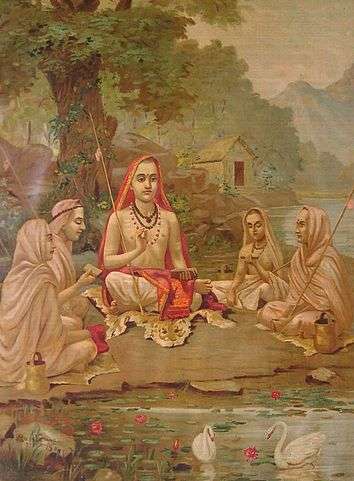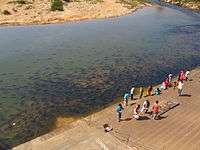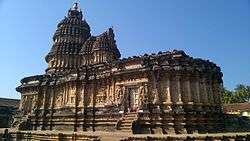Sringeri
| Sringeri ಶೃಂಗೇರಿ | |
|---|---|
| Temple town | |
|
Sri Vidyashankara temple (1342 AD) at Sringeri | |
 Sringeri | |
| Coordinates: 13°25′N 75°15′E / 13.42°N 75.25°ECoordinates: 13°25′N 75°15′E / 13.42°N 75.25°E | |
| Country |
|
| State | Karnataka |
| District | Chikkamagaluru |
| Region | Tulunadu Malenadu |
| Government | |
| • MLA | D. N. Jeevaraj |
| Elevation | 672 m (2,205 ft) |
| Population (2001) | |
| • Total | 4,253 |
| Languages | |
| • Official | Kannada |
| Time zone | IST (UTC+5:30) |
| PIN | 577139 |
| Telephone code | 08265 |
| Vehicle registration | KA-18 |
Sringeri, also written as Shringeri is a hill town and taluka headquarters located in Chikkamagaluru district in the state of Karnataka, It is the site of the first maṭha (Sringeri Sharada Peeta) established by Adi Shankara, Hindu theologian and exponent of the Advaita Vedanta philosophy, in the 8th century CE It is located on the banks of the river Tungā and also a historical Temple (1200 years).
Origin of the name
The name Sringeri is derived from Rishyashringa-giri, a nearby hill that is believed to have contained the heritage of Rishi Vibhandaka and his son Rishyashringa. Rishyashringa appears in an episode in the Bala-Kanda of the Ramayana where a story, narrated by Vasishtha, relates how he brought rains to the drought-stricken kingdom of Romapada.[1]
Legend
According to legend, Adi Shankaracharya is said to have selected the site as the place to stay and teach his disciples, because when he was walking by the Tunga river, he saw a cobra with a raised hood, providing shelter from the hot sun, to a frog about to spawn. Impressed with the place where natural enemies had gone beyond their instincts, he stayed here for twelve years. Adi Shankaracharya also established mathas in the northern (at Jyotirmath, near Badrinath), eastern (at Puri) and western (at Dwaraka) quarters of India.
Geography and Climate
Sringeri is located at 13°25′N 75°15′E / 13.42°N 75.25°E.[2] It has an average elevation of 672 metres (2204 ft).
Sringeri experiences a Tropical monsoon climate under the Köppen climate classification.
| Climate data for Sringeri | |||||||||||||
|---|---|---|---|---|---|---|---|---|---|---|---|---|---|
| Month | Jan | Feb | Mar | Apr | May | Jun | Jul | Aug | Sep | Oct | Nov | Dec | Year |
| Average high °C (°F) | 28.7 (83.7) |
30.2 (86.4) |
31.9 (89.4) |
31.8 (89.2) |
30.5 (86.9) |
26.3 (79.3) |
24.3 (75.7) |
24.7 (76.5) |
26.0 (78.8) |
27.3 (81.1) |
27.8 (82) |
28.0 (82.4) |
28.13 (82.62) |
| Average low °C (°F) | 16.0 (60.8) |
17.1 (62.8) |
19.1 (66.4) |
21.0 (69.8) |
21.3 (70.3) |
20.2 (68.4) |
19.8 (67.6) |
19.9 (67.8) |
19.6 (67.3) |
19.4 (66.9) |
17.9 (64.2) |
16.2 (61.2) |
18.96 (66.13) |
| Average rainfall mm (inches) | 3 (0.12) |
2 (0.08) |
13 (0.51) |
78 (3.07) |
111 (4.37) |
785 (30.91) |
1,398 (55.04) |
1,016 (40) |
268 (10.55) |
190 (7.48) |
70 (2.76) |
15 (0.59) |
3,949 (155.48) |
| Source #1: DES[3] | |||||||||||||
| Source #2: Climate-Data.org[4] | |||||||||||||
Demographics
As of the 2001 India census,[5] Sringeri had a population of 4253. Males constitute 52% of the population and females 48%. Sringeri has an average literacy rate of 83%, higher than the national average of 59.5%: male literacy is 86%, and female literacy is 79%. In Sringeri, 8% of the population is under 6 years of age. Kannada is spoken by the majority of the people, but Tulu is also spoken by a minority in the town mainly by those comming from Tulunadu region.
Places of interest
Sringeri is home to a number of historic temples. Of these, Sri Sharadamba temple and Sri Vidyashankara temple and parshwanath jain temple are very prominent.Other historic temples nearby are Hornadu, Kollur and Kalasa.
Sharadamba Temple

The Sharada temple, dedicated to the Goddess of learning and wisdom, has grown from a simple shrine dating to the time of Adi Shankaracharya. In the fourteenth century, Vidyaranya is said to have replaced the old sandalwood image with a stone and gold image. The temple structure itself continued to be made of wood till the early 20th century. After an unexpected fire that damaged the structure, the current structure was built in the traditional south Indian chettinadu style of temple architecture.[6]
Vidyashankara Temple
The Vidyashankara temple was built in commemoration of the pontiff Vidyashankara, around 1357-58 C.E.. It was built by Vidyaranya, patron-saint of Harihara and Bukka, the brothers who founded the Vijayanagara empire. The niches in the temple have a number of sculptures from Hindu mythology. Inscriptions in the temple record contributions made by several Vijayanagara emperors but the temple was probably built on an earlier Hoysala site as it combines Hoysala and Vijayanagara architectural features. The temple architecture is also an exhibition of the astronomical expertise of medieval south Indian temple builders. The main temple hall features 12 pillars designated for the 12 signs of the zodiac. Windows and doors along the temple walls are arranged such that equinoxes sunrise views reach the deity. The northern and southern gates enable the sunrise view from the hall during solstices. The Vidyashankara Temple was built in the year 1338 A.D. It is a unique monument built entirely of stone combining both Hoysala (Chalukya) and Dravidian architectural styles. The structure stands on a high plinth and commands a magnificent view from the hills and their slopes all round. It is more or less a rectangle with apisidal east-west ends. On the western side is the Garbhagriha, with Vidya Ganapati on one side and Durga on the other side of the entrance. On the other three sides of the Garbhagriha are shrines to Brahma, Vishnu and Maheshwara with their consorts. In the eastern half of the structure is a mantapa with twelve pillars, huge monoliths carrying large figures and carrying heavy projecting corbels on top. These twelve pillars are marked by the twelve signs of the zodiac in their regular order, and arranged in such a manner that the rays of the sun fall on each of them in the order of the twelve solar months. On the floor is a large circle, marked with converging lines to indicate the direction of the shadows. The central ceiling is an exquisite piece of workmanship with lotus and pecking parrots. The vimana over the Garbhagriha rises magnificently with shikhara, mahapadama and stupi. The rest of the roof is made up of sloping channelled slab. The basement is elaborately sculpted with animals, puranic stories, Siva, Vishnu, Dasavatara, Kali, Shanmukha and so on. From the caves of the corners of the central hall chains of stone rings hang which is a common feature of the Vijayanagar period.
To the student of Hindu iconography, this temple is a veritable store house of sculpture. The meditation of the Linga (Vidya Shankara Linga) in the sanctum and other Murtis will lead to Divine realization.
Vidyatirtha Rathotsava is celebrated on a grand scale during kartika Shukla paksha. The festival spans for seven days from Tritiya to Navami. On the Saptami day His Holiness Jagadguru Bharathi Teertha Mahaswamigal performs special Puja. Also the Aradhana of Sri Vidya Shankara is performed on shasti, saptami and ashtami. This temple is under the care of the Archaeological Survey of India owing to its architectural marvel.[7][8][9][10]
Sirimane Falls

Sirimane falls is situated at a distance of 12 km from Sringeri. Visitors can visit the place by two wheelers and small vehicles like Car, Jeep and Suvs. No public transport is available to Sirimane falls. However limited number of buses from Sringeri town till Kigga are available. Kigga is located 5 km away from the falls. One can Hire vehicles from Sringeri to visit Sirimane falls.
Hanumanagundi Falls
Hanumanagundi falls also known as Soothanabbi falls is located on the way to Horanadu Via Kudremukh. Distance between Sringeri and the waterfalls is 36 km. Waterfalls lies inside Kudremukh National forest which is famous for Shola Forests. Gangamoola the birthplace of Tunga, Bhadra and Netravati rivers also lies in this region.
Temples of Guardian deities

Sri Adi Shankara had constructed four temples on the four sides of the sringeri village.
- Kala Bhairava Temple in the East
- Kere Anjaneya Temple in the West
- Kalikamba Temple in the North
- Durgamba Temple in the South
Sri Malahanikareshwara Temple
This is located at the centre of the Sringeri town.
Sringeri Sharada Peeta

The Sringeri matha is known as Sringeri Sharada Peetha. It is one of the four Hindu Advaita maths established by Adi Shankaracharya. It is also referred to as Dakshinamnaya Sringeri Sharada peetam. Following the tradition initiated by Adi Shankaracharya, the maţha is in charge of the Yajur Veda (the Krishna (Black) Yajurveda is more prevalent in South India, over which the maţha has authority in the Smarta tradition).The head of the matha is called Jagadguru (teacher to the world) and also carries the Shankaracharya name as a title. The present Sringeri Shankaracharya is Shri Bharati Tirtha and the successor of srigeri sharada math was erected recently by mahasannidhanam jagadguru bharathi theertha mahaswamy who is sannidhanam jagadguru vidushekhara bharathi mahaswami.

Zodiac Pillars
The twelve pillars in the Vidyashankar temple are popularly known as Rashistambhas (zodiacal pillars). Symbols of the twelve divisions of the zodiac are engraved on these pillars. The temple is an architectural marvel. Among the many delicate carvings, lions that are engraved in biped positions on the pillars may be mentioned. There are stone balls inside the growling faces of the lions and they can be moved inside their mouths. It is said that the design of the pillars involved certain astronomical concepts. For example, the first rays of the rising sun fall on specific pillars with the zodiacal symbol on the pillar corresponding to the position of the sun.
How to Reach
Sringeri can also be reached from Mangalore which is at distance of 105 kilometers by road via Karkala. KSRTC operates Ac and Non ac luxury buses from Bangalore. Other travels like SRS and Sugama operate buses from Bangalore. Sringeri is situated at a distance of 86 kilometres from Chikmagalur by road. Chikkamagaluru is connected to Bengaluru and other cities through road and a rail line via Kadur.
It is 95 km from famous City Shimoga which is connected to Bangalore through Bus and Rail routes. Private buses are operated from Sringeri to Shimoga with good frequency.
Udupi is also at distance of 80 kilometres via Hebri and Agumbe. The nearest airport is Mangalore International Airport at Mangalore.
Where to Stay
- Sringeri is a small village but the number of accommodation options available is really astounding. The town has guest houses run by the temple administration. Visit Sringeri Mutt web site for details. There are many private lodges also.
Best time to visit
Since Sringeri is situated in the Malnad region, the best time to visit is between October and March.
See Also
References
- ↑ "The legend of Rishyasringa". Sringeri Sharada Peeta. Retrieved 2006-11-07.
- ↑ Falling Rain Genomics, Inc - Sringeri
- ↑ "DES" (PDF). DES. Retrieved 7 July 2016.
- ↑ "CLIMATE: SRINGERI". Retrieved 18 February 2016.
- ↑ "Census of India 2001: Data from the 2001 Census, including cities, villages and towns (Provisional)". Census Commission of India. Archived from the original on 2004-06-16. Retrieved 2008-11-01.
- ↑ "Sri Sharadamba Temple". Sringeri Sharada Peeta. Retrieved 2006-11-07.
- ↑ http://www.sringeri.net/temples/sri-vidyashankara|accessdate= 2015-03-15|
- ↑ "Sri Vidyashankara Temple". Sringeri Sharada Peeta. Retrieved 2006-11-07.
- ↑ "Zodiacal pillars of Sringeri" (PDF). Current Science. Indian Academy of Sciences. Retrieved 2006-03-25.
- ↑ "Vidyashankara Temple". Indiantemples.com. Retrieved 2006-11-07.
External links
| Wikimedia Commons has media related to shringeri. |
-
 Sringeri travel guide from Wikivoyage
Sringeri travel guide from Wikivoyage - A Photo Essay of Sringeri
- Some offbeat photos of Sringeri
- Shankara Sringeri
- Useful Travel Information
